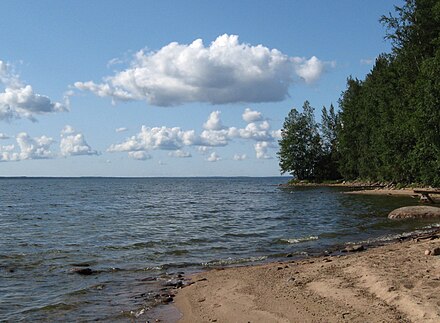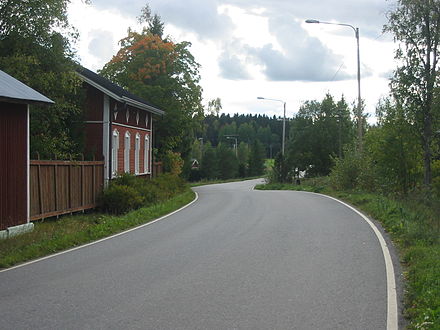Inland of Finland Proper
Inland of Finland Proper
The Inland of Finland Proper is a mostly rural region, with the large lake Pyhäjärvi (of Säkylä, not to be confused with Pyhäjärvi of Tampere or any other of its namesakes) in the north. The region can be a nice sidetrip from Turku, for biking or activities such as canoeing or horseback riding. Sights include the manor of Louhisaari and stops of the St. Henrik pilgrimage route.
Villages
Most of the important villages are or were formerly municipal centres, and still have their (former) parish churches.
- Alastaro, with a motor sports centre (part of Loimaa)
- Aura, with popular dances in the winter season
- Koski
- Marttila (S:t Mårtens)
- Mellilä (part of Loimaa)
- Nousiainen (Nousis), which had the bishop seat of Finland until 1229
- Oripää
- Pöytyä (Pöytis)
- Vahto
- Yläne, with Luontokapinetti nature exhibition and hiking services
Other destinations

- Kurjenrahka National Park and Vaskijärvi Nature Reserve
- Kurjenrahka, 60.7258°, 22.4078°.
- Vaskijärvi, 60.8446°, 22.2746°.
Understand
This is mostly an agricultural region, with much of the Finnish grain crop. Most of the villages are quite small, with some hundred to some thousand inhabitants for the above mentioned parish villages.
Towns in the vicinity include Turku in the south-west, Uusikaupunki in the north-west, Loimaa in the north-east, and Salo in the south-east.
In contrast to the southern coast, the region is monolingually Finnish. English is spoken as elsewhere in Finland.
The climate resembles that of southern Finland in general, but is somewhat more continental than on the coast, with more reliable snow cover in winter.
The region borders (clockwise) Satakunta in the north, Tavastia Proper in the east, and Salo, Turku and the Vakka-Suomi region (with Uusikaupunki) of Finland Proper.
Get in
By train
Loimaa has a station on the Turku–Tampere railway, with a train most hours in daytime, and Highway 9 leads from there to Turku through the region. Salo is on the Helsinki–Turku railway, with similar services. Especially Turku, but also Salo and Loimaa, can be good starting points for a visit.
By bus
Coaches to Turku from Tampere, Hämeenlinna, Pori and Uusikaupunki pass through the region, which means it has quite good connections. From Helsinki, you mostly have to transfer in Turku or Salo. Many of these buses are express services, not necessarily stopping exactly where you are going, unless you are visiting the main villages. There are also some other services. See Matkahuolto for the coach connections.
Vahto (as part of Rusko) has Föli buses. The Föli buses to Tortinmäki (in summer onwards to the Kuhankuono stop) can get bikers reasonably close to e.g. Aura.
By car
National road 8 (E8) passes through Masku, Nousiainen and Mynämäki, continuing through Vakka-Suomi towards Rauma, Pori and Vaasa. Highway 9 between Turku and Tampere passes by Lieto and through Aura, Kyrö (near Pöytyä), Mellilä and Loimaa. Highway 10 between Turku and Hämeenlinna passes through Lieto, by Tarvasjoki and through Marttila and Koski. The Hämeen Härkätie, partly following the same route, was along with the King's Road by the southern coast the main road of medieval Finland, with much of its history preserved.
National road 2 between Helsinki and Pori passes north of Loimaa.
Other important roads include national road 41 from Aura via Pöytyä and Oripää towards Virttaa and Huittinen, regional road 204 from Lieto via Kurjenrahka national park and Yläne towards Säkylä and Eura, regional road 213 from highway 10 and Ypäjä via Loimaa and Alastaro to Säkylä, and road 192 (Kustavintie) via Lemu and Mietoinen to Kustavi, with a fork to Askainen.
Get around
Coaches travel along the main roads and sparsely along some other roads. A few roads are served by the Föli buses, see above. The main villages are decently served, but many places rely on own car, bike, taxi or school buses.
By taxi
- Taksi Länsi-Suomi, +358 100 0700 (shared cost number). The traditionally dominant call centre in the region.
- Valopilkku (national app by Taxi Helsinki)
- 02 Taksi (national app)
By bicycle
There are older roads running more or less in parallel with the main roads, in decent condition but with much less traffic (and usually more interesting surroundings). Also some connecting roads offer similar connections. Thus reaching points of interest by bike is often easy, if you have a decent map. Hämeen Härkätie is one such recommended route. The main roads are best avoided, especially in the dark, in rain and in winter, except sections with separate biking lanes – and the biking lanes often follow the former main road. Those with terrain bikes might want to use the terrain bike route from Turku to the national park (much harder than the other routes, but you have the choice).
There may be a biking map available.
See
Old churches and cultural landscapes
- Aura Church, Turuntie 437 (Prunkkala/Kirkonkulma, Aura), 60.6091°, 22.5624°. Church from 1804.
- Saint Henry's Church (Nousiainen Church), Kirkkotie 212, 60.6161°, 22.1285°, +358 44 431 8549. Services Su 10:00 and at special occasions, otherwise open by agreement. An important example of Finnish medieval church architecture. This was the site of the first bishop seat of Finland and saint Henry, regarded first bishop and patron saint of Finland, was buried here. The church was probably finished in the 1420s, at the site of earlier wooden churches. The bell tower was built 1759–1760. The rectory on the other side of the river has been on the same site since the 13th century, with the current main building from 1890. The Saint Henry's Way pilgrimage leads to the church from Köyliö, where he was murdered according to the legend.
- Vahdon kirkko, Kanttorilantie 1, 60.6095°, 22.3073°, +358 44-720-3713. Wooden church from 1804. Bells moved from the separate bell tower to the new at the church in 1873. Crusifix from 1665.
- Local history museums in Alastaro, Loimaa, Marttila, Nousiainen, Oripää, Pöytyä, Tarvasjoki and Yläne
- Koskipirtti, Riihikoskentie 36, Aura (Kuuskoski village, Aura), 60.6584°, 22.5929°, +358 40-720-9101, koskipirtti@gmail.com. Groups by agreement. Interiors and items from early 20th century in a wooden mansion from the 1860s.
- Nousiaisten kotiseutumuseo, Topoistentie 11 (Nousiainen), 60.6113°, 22.1213°, +358 40-551-6045 (Juha Saarinen). In summer: Su 12:00–15:00. Several 18th century houses.
- Reppuniemi open air museum (Reppuniemi ulkomueoalue), Turuntie 1047 (Pöytyä), 60.7505°, 22.6404°, +358 500-525-984. By agreement. 2017-02-07
Do

-
Hike to and in Kurjenrahka National Park or along the Heikola trail from Marttila
-
Fish in lake Pyhäjärvi, through the ice in winter. With some timing and luck you could join a group ice fishing with a huge dragnet (seine) under the ice, traditionally with the help of horses, now tractors
-
Camp and swim by the shores of Elijärvi, Pyhäjärvi or some other lake
-
Follow Saint Henry's Way, a modern pilgrimage trail. St. Henry is regarded the national saint of Finland, although not formally recognized by the catholic church. The trail is marked and can be walked at any time, but there are also organized pilgrimages yearly, with a pilgrimage covering all the 140 km every third year.
-
Dance at Valasranta (Yläne/Pöytyä), Pappisten lava (Loimaa) or Auran nuortentalo (Aura)
- Valasranta, Valasrannantie 363, 60.8960°, 22.3479°, +358 2 256-3605 (best reached W–Su). 6 May–1 Oct: Sa 20:30–01:30; courses all day 21–29 Jul. Dance pavilion by a beach of Pyhäjärvi. Social dancing in the summer since 1955. Ice swimming Saturdays in the winter (to 29 April). Caravan camping with sauna on dancing weekends (also by the month). Caravan €15, dances €15–20 2017-02-17
- Pappisten lava, Pappistenjärventie 42 (9 km west-south-west from Loimaa, 1.5 km south-west from Pappinen), 60.7983°, 22.8575°. Jun–Aug: F 20:00/21:00–01:00, July also Tu 20–24. Dance pavilion by the lake Pappistenjärvi. Most Fridays a course of some dance an hour before the dancing proper is included in the price. €14, €8 for those under 25 in June and August. Cash only 2018-04-08
- Auran nuortentalo, Kirkkotie 254, Aura, 60.6228°, 22.5332°, +358 40-514-2468, aurannuortentalo@aurannuortentalo.fi. Oct–Apr: Sa 19:00/20:00–01:00. Dances popular among young and old alike, with much of the dancers coming from Turku. The ticket price includes a one hour dance course on one dance (varying by week), before the real dancing begins. €16+1 2017-10-10
-
Canoe along Paimionjoki river or to Turku along Aurajoki river (few whitewater thrills, but nice landscapes)
- Silver river, Heinojantie 69, Prunkila, 60.5665°, 22.8047°, +358 50-556-8920, silverriver@marttila.fi. Cottages, rooms; canoeing, bow and arrow or paintball shooting, sumo wrestling and other activities. lodging €30–70; 2-hour canoeing trip with guide €150/6 pers, canoe two hours €16, one day €30 2017-02-12
-
Go horse riding
- Kylämäki farm (Kylämäen hevostila), Hallintie 31, Marttila, 60.5765°, 22.8948°, +358 44-484-5800, info@unki.fi. Lodging and horse riding, including overnight tours (Finn horses or your own) 2017-02-12
- Varjo-talli, Ojalantie 10 (Vahto), 60.5836°, 22.2645°, +358 400-848-616 (14:00–17:00 or SMS), varjo-talli@varjotalli.fi. Terrain tours by request. €25/1 hr, €35/2 hr 2017-02-17
-
Haukkavuori, Haukkavuorentie 43 (Riihikoski, Pöytyä, west of road 41), 60.7257°, 22.5611°, +358 2 481-000 (municipal exchange), kunta@poytya.fi. Stepping stairs (132 steps); 18-basket disc golf course; 5-km illuminated jogging/skiing route (info on snow conditions), branch to the Haukkavuori trail to Kuhankuono, lean-to shelter after 1.5 km.
-
Rantapiha, Savojärventie 102 (Savojärvi), 60.7429°, 22.3909°, +358 500-935-960 (Saksalan pienviljelijäyhdistys). Sauna 11:00–20:00 during school holidays; beach 24 hr daily. Beach, sauna, barbequeing, small scale camping, kiosk. Rowing boats for hire. Sauna for rent off season. Free
Events
- Jazzkukko, Laitila. Month: July. Swing and jazz festival in Laitila.
Buy
Eat and drink
Few proper restaurants. Most food is found at lodgings, see below and check whether advance booking is needed. Also fuel stations by the main roads can be used, such as by Aura.
Sleep
One of the regions where variants of bed and breakfast, cottages and camping are the main options. Wild camping according to the right to access is possible, but look for a little bigger woods, where you are unlikely to be seen by passers-by – or better yet: use the designated sites at hiking trails.
Alastaro
- Kannisto farm, Kannistontie 172, +358 2 764-1162, info@kannistontila.fi. Agritourism farm. Food largely local produce (to be ordered in advance). Rabbits, horses, cattle, deer etc. €92–104, full board €116–128, B&B €76–88 (children 2–14 1/4 or 1/2 price); visit €5, lunch or diner weekdays €9, Su €14 2017-02-12
Vahto
- Vajosuo rental hut, +358 400-274-523, mika.lehto1@kolumbus.fi. May–September. Spartan cottage. Pets permitted. Gas cooker for cooking, wood fired heating stove, platform bed for four. Water and bedding (including mattresses? check) have to be brought. €25/night
Yläne
- Eskola's cabins, +358 400-476-267, ismo.eskola@pp.inet.fi. Cottages near Elijärvenkulma and Vaskijärvi 2017-02-12
- Kurala manor, Kuralantie 11, +358 2 256-3203, info@kuralankartanotila.fi. €80–95 2017-02-12
Connect
- Auran kirjasto, Urpontie 2 (Aura centre), 60.6497°, 22.5889°, +358 40-127-2951, kirjasto@aura.fi. M–F. Library. Wi-Fi, scanner, printer.
- Kyrön kirjasto, Kyröntie 16, +358 40-672-2968, +358 40-7274-494, kyron.kirjasto@poytya.fi. M Tu Th 13–19 W F 10–16. Library. Public computers, Wi-Fi, printer.
- Nousiaisten kirjasto, Moisiontie 17 (Nousiainen centre), 60.6016°, 22.0872°, +358 44-435-5355, riikka.uski@nousiainen.fi. M–Th 12:00–19:00 F 09:00–16:00. Library. Wi-Fi, public computer, printer. Also foreign newspapers and magazines available on the net. Exhibitions.
- Riihikosken kirjasto, Yläneentie 6, +358 40-672-2967, +358 40-727-5878, kirjasto@poytya.fi. M–W 13–19 Th 10–16 F 9–15. Library. Public computers, Wi-Fi, printer.
- Vahdon kirjasto, Laukolan koulutie 2 B (Vahto centre), 60.6105°, 22.3048°, +358 44-433-3666, vahdon.kirjasto@rusko.fi. M Th 13:00–19:00 Tu (W) 10:00–15:00. Library. public computers, scanner, toilets. Not accessible by wheelchair.
- Yläneen kirjasto, Vainionperäntie 2a, +358 40-672-2970 (also tourist information), +358 50-590-6748, ylaneenkirjasto@poytya.fi. M Tu Th 13–19 F 10–16. Library. Public computers, Wi-Fi, printer. Tourist information for Pöytyä.
Stay safe
The area is safe. For wildlife, normal advice applies; wildlife has not been acquainted to hikers' food.

